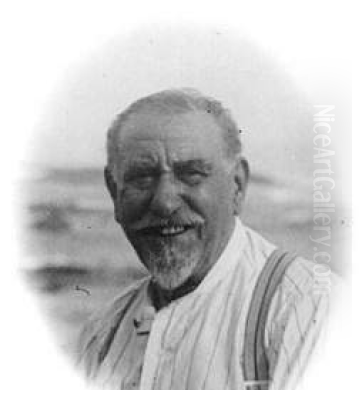
Antonio María Reyna Manescau stands as a significant figure in late 19th and early 20th-century Spanish art, renowned primarily for his exquisite and luminous depictions of Venice. Though Spanish by birth and training, he spent the majority of his prolific career in Italy, capturing the unique atmosphere, architecture, and daily life of 'La Serenissima' with remarkable precision and sensitivity. His work, deeply rooted in the tradition of Veduta painting, combines meticulous detail with a vibrant Mediterranean sensibility, earning him considerable acclaim, particularly among international collectors. This exploration delves into the life, art, and legacy of a painter who, while embracing an Italian subject, never forgot the light of his native Andalusia.
Early Life and Artistic Formation in Spain
Antonio María Reyna Manescau was born on December 31, 1859, in the town of Coín, located in the province of Málaga, Andalusia, Spain. From an early age, he demonstrated a natural inclination towards the visual arts, showing promise in drawing and painting. His family recognized his talent, and he received his initial artistic training locally before progressing to the Escuela de Bellas Artes de Málaga (School of Fine Arts of Málaga). This institution was a crucial stepping stone, providing him with a solid foundation in academic drawing and painting techniques, following the traditional Spanish curriculum of the time.
During his formative years in Málaga, Reyna Manescau honed his skills, likely studying the works of earlier Spanish masters and participating in the local art scene. His talent did not go unnoticed. Early exhibitions of his work in Málaga garnered positive attention, showcasing his developing command of composition and color. Some sources suggest he may have also spent time refining his abilities at the Liceo Artístico de Madrid, further immersing himself in the broader currents of Spanish art before his pivotal move abroad. His early works already hinted at the qualities that would define his mature style: a keen eye for detail, a fluid brushstroke, and an innate understanding of light and shadow.
The Journey to Italy: A Scholarship to Rome
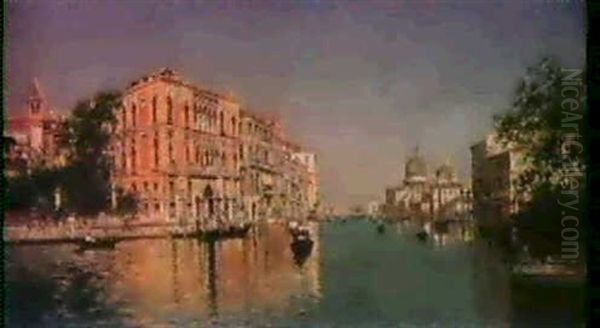
The year 1882 marked a turning point in Reyna Manescau's life and career. Recognizing his exceptional potential, he was awarded a prestigious scholarship by the Diputación Provincial de Málaga (Provincial Council of Málaga). This grant enabled him to travel to Rome, the eternal city that had drawn artists from across Europe for centuries. Rome, with its classical ruins, Renaissance masterpieces, and vibrant contemporary art scene, offered an unparalleled environment for artistic growth and inspiration.
Upon arriving in Rome, Reyna Manescau immersed himself in his studies and the city's artistic milieu. He likely spent time sketching ancient monuments, studying the works of Old Masters in museums and churches, and connecting with other artists. Critically, he became associated with the circle of Spanish artists residing in Rome, a community that included prominent figures like José Villegas Cordero. Villegas, an established and successful painter known for his historical and genre scenes, likely served as a mentor or influential contact for the younger Reyna Manescau. This period in Rome broadened his horizons and exposed him to international artistic trends, including the lingering influence of Orientalism and the enduring appeal of academic realism.
While in Rome, Reyna Manescau continued to develop his technical skills. He produced works that demonstrated his academic training, including studies and possibly some historical or biblical compositions, such as the mentioned Joseph in the Pit. He also began painting views of Rome itself, capturing its iconic landmarks and picturesque corners. This early engagement with cityscape painting laid the groundwork for his later specialization, although it would be another Italian city that would truly capture his artistic imagination.
Venice: The Muse of a Lifetime
Although Rome provided invaluable training and connections, it was Venice that became the central focus and enduring inspiration for Antonio María Reyna Manescau's art. It is unclear exactly when he first visited Venice, but the city's unique charm—its shimmering canals, magnificent palaces, bustling squares, and ethereal light—clearly captivated him. He eventually established himself primarily between Rome and Venice, dedicating a significant portion of his output to capturing the Venetian landscape.
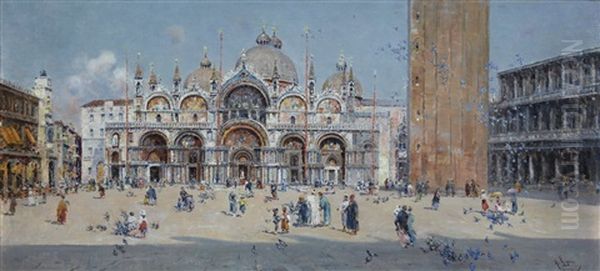
Reyna Manescau joined a long and distinguished line of artists drawn to Venice, following in the footsteps of historical Vedutisti like Canaletto (Giovanni Antonio Canal) and Francesco Guardi. However, he brought his own distinct perspective to the genre. While Canaletto was known for his almost photographic precision and Guardi for his atmospheric, looser brushwork, Reyna Manescau forged a style that balanced meticulous architectural detail with a vibrant, light-filled atmosphere. He excelled at rendering the textures of stone and water, the play of sunlight on facades, and the reflections in the canals.
His Venetian scenes often depict famous landmarks such as the Grand Canal, the Rialto Bridge, St. Mark's Square, the Doge's Palace, and Santa Maria della Salute. Yet, he was equally adept at capturing the charm of quieter, less monumental corners of the city—narrow side canals, intimate campielli (small squares), and gondolas gliding silently through the waterways. He populated these scenes with small figures, often elegantly dressed locals or gondoliers, adding a sense of life and scale without detracting from the architectural focus. These figures contribute to the narrative quality of his work, suggesting the daily rhythms of Venetian life.
Artistic Style: Precision, Light, and Color
Reyna Manescau's artistic style is characterized by a remarkable synthesis of detailed realism and atmospheric luminosity. His training in the Spanish academic tradition provided him with superb draftsmanship, evident in the precise rendering of architectural elements. He paid close attention to perspective and structural accuracy, ensuring his depictions of Venetian palaces and churches were both recognizable and convincing. This dedication to detail appealed greatly to the tastes of the time, particularly to tourists and collectors seeking faithful souvenirs of their travels.
However, his work transcends mere topographical accuracy. Reyna Manescau possessed a masterful understanding of light and color, likely influenced by both the unique aquatic light of Venice and the brighter sun of his native Andalusia. His canvases often glow with a warm, clear light that illuminates facades, sparkles on the water, and casts delicate shadows. His color palette is rich and varied, employing vibrant blues for the sky and water, warm ochres and pinks for the buildings, and touches of brighter hues for figures and details, creating compositions that are both harmonious and visually engaging.
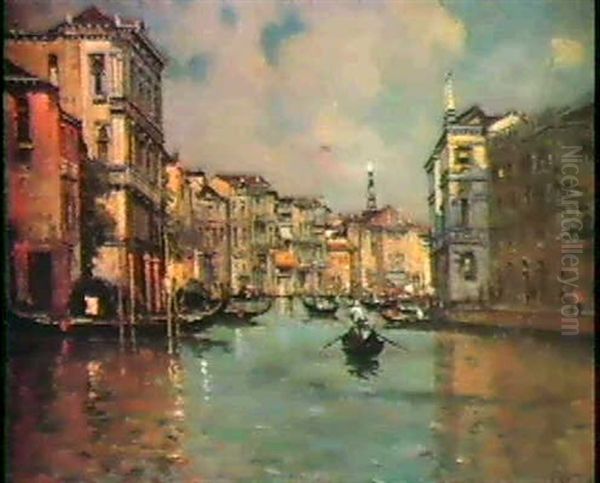
His brushwork, while precise in rendering details, could also be fluid and expressive, particularly in depicting water and sky. He skillfully captured the reflective quality of the canals, showing the interplay of light, shadow, and the mirrored images of buildings. Compared to some of his contemporaries who specialized in Venetian scenes, such as the Peruvian painter Federico del Campo, known for his highly polished finish, or the Spanish artist Martín Rico y Ortega, whose work often had a brighter, sunnier palette, Reyna Manescau maintained a distinctive balance between meticulousness and atmospheric effect. His paintings evoke not just the appearance of Venice, but also its unique mood and elegance.
Key Themes and Representative Works
While Venice dominated his output, Reyna Manescau's oeuvre included other subjects. His time in Rome resulted in numerous views of that city, capturing its classical grandeur and picturesque streets. Some accounts suggest an engagement with Orientalist themes, possibly influenced by contemporaries like Mariano Fortuny or his associate José Villegas Cordero, although Venetian and Roman views remain his most recognized contribution.
One of his most frequently cited non-Venetian works is El cardenal tomando chocolate (The Cardinal Drinking Chocolate). This painting showcases a different facet of his talent, moving into genre painting with a focus on interior scenes and character study. It depicts a high-ranking church official in a richly decorated room, enjoying a moment of repose. The work is noted for its detailed rendering of fabrics, furniture, and decorative elements, as well as its skillful use of color and light to create a sense of intimacy and quiet luxury. This piece demonstrates his versatility beyond landscape and cityscape.
His connection to his homeland occasionally surfaced in works like Andalusian Ranch, reminding viewers of his Spanish roots and his ability to capture the distinct light and atmosphere of southern Spain. Early works, potentially from his scholarship period, included biblical subjects like Joseph in the Pit, showcasing his academic training in figure painting.
However, his fame rests squarely on his Venetian vedute. Specific titles often vary or are descriptive, such as View of the Grand Canal, St. Mark's Square, Venice, The Rialto Bridge, A Venetian Backwater, or Gondolas on a Venetian Canal. Works like Venice, Three Elegant Ladies Strolling by the Quay or Venice, Animated Canal with Gondolas and Figures exemplify his typical compositions: architecturally accurate settings animated by small figures, all bathed in his characteristic luminous light. These paintings were highly sought after and remain popular in the art market today.
Contemporaries and Artistic Context
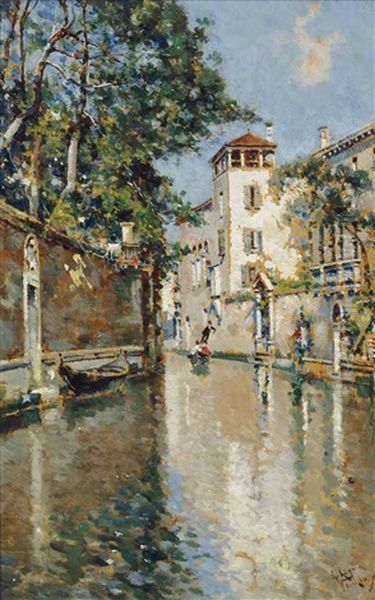
Antonio María Reyna Manescau worked during a vibrant period in European art. In Italy, he was part of a large international community of artists. His association with fellow Spaniard José Villegas Cordero in Rome was significant. He would also have been aware of other prominent Spanish artists active in Italy, such as José Benlliure y Gil and Salvador Sánchez Barbudo, who often painted historical or genre scenes, and Enrique Serra Auqué, known for his Roman landscapes. While perhaps not directly interacting with all of them, he operated within this shared context of expatriate Spanish artists finding inspiration and patronage abroad.
His specialization in Venetian views placed him alongside other Vedutisti of the era. He can be compared to Martín Rico y Ortega, another Spanish painter who achieved great success with his sparkling depictions of Venice, often characterized by even brighter light and more bustling activity. Peruvian artist Federico del Campo was perhaps his closest rival in terms of detailed Venetian scenes catering to the tourist market. Italian painters like Rubens Santoro and Giacomo Favretto (though more focused on genre scenes within Venetian settings) also contributed to the rich artistic production centered on Venice during this period. Earlier Italian masters like Luigi Querena continued the veduta tradition into the 19th century.
While distinct in style from the Impressionist-influenced work of Joaquín Sorolla, or the earlier, more dramatic Orientalism of Mariano Fortuny, Reyna Manescau represents an important aspect of Spanish art at the turn of the century: the continuation of academic realism combined with a sensitivity to light and place, often finding its subject matter outside of Spain itself. His work appealed to a taste for detailed, picturesque views that remained popular even as modernist movements began to emerge.
Reception, Legacy, and Later Life
Antonio María Reyna Manescau achieved considerable success during his lifetime. His meticulously rendered and beautifully lit Venetian scenes found a ready market, particularly among affluent tourists, including many British and American collectors undertaking the Grand Tour or seeking elegant mementos of their travels. His paintings were praised for their technical skill, compositional harmony, and evocative portrayal of Venice's unique charm. He was sometimes referred to, especially by English collectors, simply as one of the great "Painters of Venice," a testament to his identification with his chosen subject.
His works were exhibited internationally and continue to fetch significant prices at auction houses like Christie's and Sotheby's, demonstrating their enduring appeal. Examples like Venice, Three Elegant Ladies Strolling by the Quay (estimated at €30,000-€50,000 in a Milan auction) or Venice, Animated Canal with Gondolas and Figures (estimated at €18,000-€24,000 in Antwerp) reflect his solid standing in the art market for 19th-century European paintings.
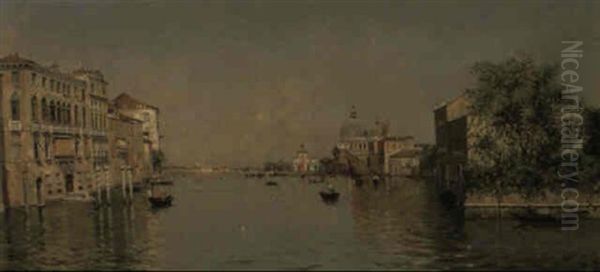
Details about his personal life are relatively scarce, but it is known that he married Beatriz Milantoni (or possibly Milanilli/Milantili – spellings vary), described by some sources as a singer, suggesting a connection to the broader cultural world of Italy. He remained based primarily in Rome for the rest of his life, continuing to paint until his later years.
A significant aspect of his legacy is tied to his hometown. The Fundación García Agüera in Coín, Málaga, was established partly in his honor, working to preserve his memory and promote culture in the region. This foundation holds exhibitions and contributes to the understanding of his work and his place within Andalusian and Spanish art history. Antonio María Reyna Manescau passed away in Rome on February 3, 1937, leaving behind a substantial body of work that continues to enchant viewers with its timeless depictions of Venice.
Conclusion: A Spanish Eye on Venetian Waters
Antonio María Reyna Manescau carved a unique niche for himself in the art world of the late 19th and early 20th centuries. As a Spanish artist who dedicated the majority of his career to capturing the landscapes of Italy, particularly Venice, he bridged cultural traditions. His work stands as a testament to the enduring allure of Venice for artists and the continued vitality of the Veduta tradition. He combined the rigorous technical skill fostered by his Spanish academic training with a profound sensitivity to the interplay of light, water, and architecture that defines Venice.
While contemporaries like Sorolla explored Impressionism or Zuloaga pursued a darker Spanish realism, Reyna Manescau perfected a luminous, detailed style that captured the picturesque elegance sought by international audiences. His paintings are more than just accurate representations; they are evocative portals into the serene beauty and timeless atmosphere of Venice, seen through the discerning eye of a Spanish master. His legacy endures not only in museums and private collections but also in the continued appreciation for finely crafted paintings that celebrate the beauty of the world's most iconic cityscapes.